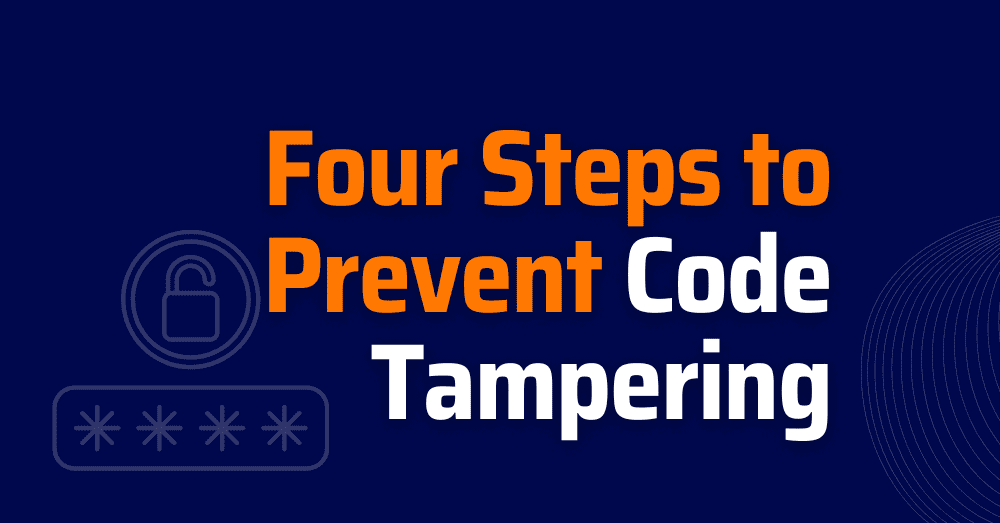Code tampering refers to the unauthorised modification or alteration of source code during software application development, testing, or deployment. This malicious activity can have devastating consequences, from introducing security vulnerabilities to altering the intended behaviour of the software, causing it to fail in unexpected ways.
Code tampering prevention is a serious concern for businesses in today’s digital age. CIOs, CISOs, and DevOps teams are tasked with ensuring the security and reliability of the applications they develop and deploy. Code tampering prevention is a critical part of this effort.
How can you prevent code tampering?
Verification is the first step in preventing code tampering. It involves establishing a secure development environment where only authorised personnel can access the source code. It can include implementing access controls, such as user authentication and authorisation, to restrict access to sensitive code repositories. Additionally, code signing and digital signatures can be used to verify the authenticity of code and detect any tampering that may have occurred. By establishing a secure development environment, businesses can ensure that code is only modified by authorised personnel and that any modification is easily detectable.
Detection is the second step in preventing code tampering. It involves monitoring code changes and alerting developers and security teams when changes are detected that deviate from expected behaviour. This can be accomplished through the use of code analysis tools, such as code scanners and continuous integration (CI) systems, which can detect code changes and highlight potential security vulnerabilities. Detection can also be accomplished through runtime protection techniques, such as code obfuscation and tamper-proofing, which can help prevent code tampering and protect against attacks. In addition, these techniques can help ensure that code is executed in its intended form, even if tampering has occurred.
Monitoring is the third step in preventing code tampering. It involves constantly monitoring code for changes and detecting any unauthorised modifications that may have been made. This can be accomplished through code analysis tools, such as code scanners, and runtime protection techniques, such as code obfuscation and tamper-proofing. Additionally, monitoring can be accomplished through log analysis and monitoring systems, which can help identify and detect any unauthorised code changes. By continuously monitoring code, businesses can quickly identify and respond to any potential code tampering, ensuring that applications remain secure and reliable.
Governance is the final step in preventing code tampering. This involves establishing policies and procedures to govern the development and deployment of software applications. This can include defining best practices for secure codings, such as using secure coding practices, conducting code reviews, and implementing automated code testing tools. Additionally, governance can involve establishing incident response procedures to respond to code tampering incidents and mitigate their impact. By setting clear policies and procedures, businesses can ensure that code tampering is prevented and that incidents are handled quickly and effectively.
Watch our non-gated SafeDev Talk on The True Value of Using All-In-One Platforms in AppSec and discover how you can prevent all kinds of software supply chain threats – from secret leaks and dependency attacks to code tampering – without slowing down development.
Xygeni Solution for Code Tampering Prevention
Xygeni is a leading provider of code tampering prevention solutions. Xygeni solutions help businesses like yours prevent code tampering by offering comprehensive security tools, including verification, detection, monitoring, and governance.
Verification tools help ensure that code is only modified by authorised personnel. In contrast, detection tools help monitor code changes and alert developers and security teams when deviations from expected behaviour are detected.
Monitoring tools continuously monitor code for changes and provide real-time alerts to help businesses respond to potential code tampering incidents, while governance tools establish clear policies and procedures to govern the development and deployment of software applications.
- Real-time monitoring – One of the critical features of Xygeni solution code tampering prevention is its ability to detect and prevent code tampering in real-time. This helps ensure that code tampering incidents are quickly identified and addressed, minimising the risk of harm to the business.
- Advanced protection – In addition to its real-time monitoring capabilities, Xygeni solution offers advanced code obfuscation and tamper-proofing techniques to help protect against code tampering. The code obfuscation tools scramble the code, making it difficult for attackers to modify or understand it, while tamper-proofing techniques help ensure that code is executed in its intended form, even if tampering has occurred.
- Ease of use – Tools are designed to integrate seamlessly with existing development processes, making it easy for businesses to adopt and implement their solution. A user-friendly interface makes it simple for developers and security teams to monitor code for changes and respond to potential code tampering incidents.
- Scalability – Finally, our code tampering prevention solution is highly scalable, making it ideal for businesses of all sizes. Whether you are a small startup or a large enterprise, we can help you prevent code tampering and ensure the security and reliability of your software applications.
Conclusion
Code tampering seriously threatens the security and reliability of software applications. By implementing a comprehensive code tampering prevention solution, businesses can ensure that code is only modified by authorised personnel, that changes are quickly detected and addressed, and that code is executed in its intended form, even if tampering has occurred.
Xygeni solution is a leading provider of code tampering prevention, offering comprehensive security tools, including verification, detection, monitoring, and governance. If you’re looking for a solution to help prevent code tampering, do not hesitate to contact us.

